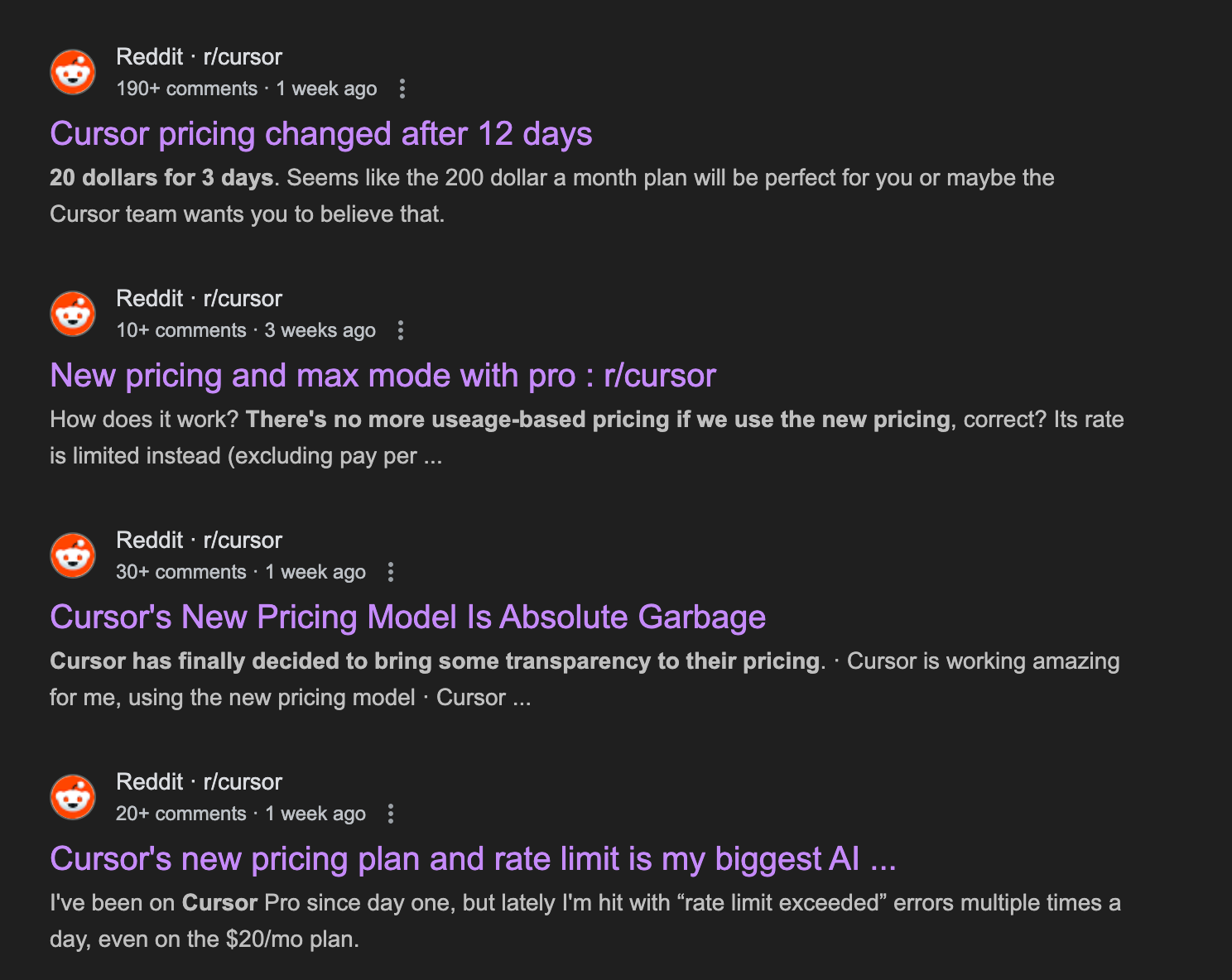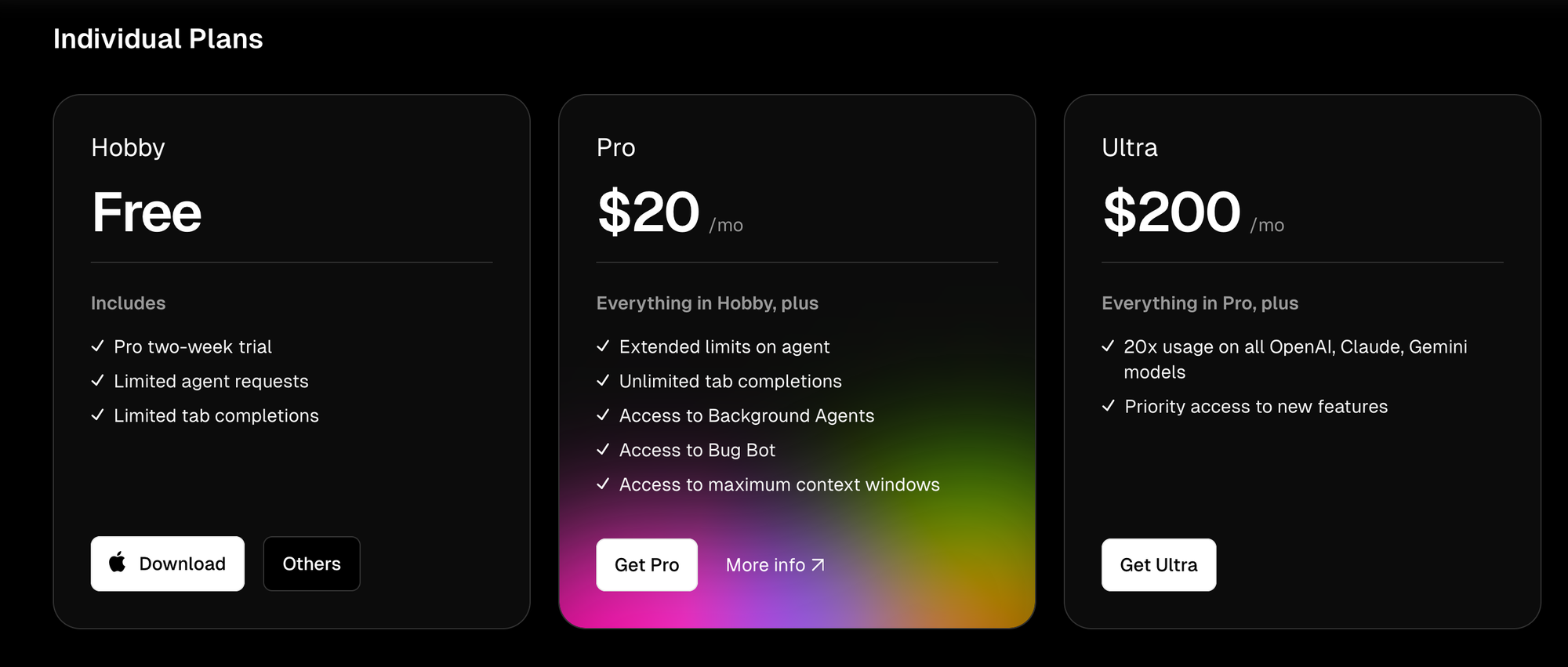
The Cursor IDE Pricing Crisis: Why $20 for Unlimited AI Was Never Going to Work (And the Real Problem is Much Bigger)
The past two weeks have been rough for Cursor IDE users. What started as pricing changes that "were not communicated clearly" has sparked a broader conversation about the sustainability of AI-powered development tools. While angry customers rightfully called out the company's handling of their pricing overhaul, the real story goes much deeper than poor communication or even unsustainable pricing models.

The bottom line: Cursor's pricing crisis is a symptom of a fundamental strategic vulnerability that threatens not just their business model, but their entire existence.
The Immediate Crisis: What Went Wrong
In June 2025, Cursor transformed their straightforward $20 Pro plan from offering 500 guaranteed fast requests to an "unlimited" usage model with arbitrary rate limiting and a $20 monthly usage cap. The backlash was swift and severe.
Users who had paid for predictable access suddenly found themselves "degraded to the point of complete inability to generate content" and facing unexpected overage charges. Some developers burned through their monthly allowance "after just a few prompts when using Anthropic's new Claude models".
The company was forced to issue a public apology and offer refunds, but the damage was done. What was once "a reliable 500 request guarantee became 'unlimited' requests with arbitrary rate limiting", breaking one of Cursor's biggest selling points: transparency.

Why $20 for Unlimited AI Never Made Sense
Let's be honest about the economics here. Anthropic's Claude Opus 4 costs $15 per million input tokens and $75 per million output tokens – that's more expensive than ever. When a single complex coding session can easily consume thousands of tokens, the math on unlimited access for $20 simply doesn't work.
As Cursor CEO Michael Truell noted, "new models can spend more tokens per request on longer-horizon tasks", meaning AI models have become significantly more expensive to operate. Cursor was essentially subsidizing power users at unsustainable rates.
But here's the thing: any developer doing serious work could see this coming from miles away. The writing was on the wall the moment Claude 3.5 Sonnet became the go-to model for coding tasks.
The Real Problem: Playing in Someone Else's Sandbox
While everyone's focused on pricing drama, they're missing the forest for the trees. Cursor's existential crisis isn't about finding the right price point – it's about the fundamental weakness of their strategic position.

Cursor is essentially a really nice IDE built on VS Code with excellent AI integrations. That's it. They've built a beautiful wrapper around other people's technology:
- The editor: VS Code (Microsoft's)
- The AI models: Primarily Claude (Anthropic's), GPT (OpenAI's), etc..
- The core innovation: Smart integration and user experience
This puts them in an incredibly vulnerable position. They're playing in someone else's sandbox, and the sandbox owners are starting to notice.
The Model Providers Are Coming for Their Lunch
Here's what should really worry Cursor (and their investors): Anthropic has launched Claude Code, their own terminal-based coding assistant that "connects with the tools that power development" and integrates directly with GitHub, GitLab, and command line tools.
Meanwhile, Anthropic has been systematically cutting off third-party access to their models. They recently "cut off Windsurf's direct API access to Claude 3.x models" with less than five days' notice, forcing competitors to rely on more expensive third-party inference providers.
The message is clear: model providers want to capture the value they're creating directly, not subsidize competitors.
The Great Reshuffling: Who's Buying Whom
The AI coding space is consolidating rapidly, and it's revealing who has real strategic value:
- Google recently hired Windsurf's CEO and key staff for $2.4 billion after OpenAI's acquisition talks fell apart
- OpenAI initially approached Cursor about an acquisition but was turned down
- Cursor is reportedly generating around $300 million in annual recurring revenue, doubling every two months
The pattern is clear: the big AI companies want to own the developer relationship directly, not just license their models to intermediaries.
Microsoft's Quiet Power Play
While everyone watches the startup drama, Microsoft is making arguably the smartest move. VS Code is adding AI capabilities that let users "plug in ChatGPT, Copilot, Claude, Gemini, or any model via API key", essentially turning the world's most popular code editor into a universal AI coding platform.
This is brilliant strategy: instead of building their own AI coding startup, they're making their existing ubiquitous tool AI-ready. Why compete with Cursor when you can make Cursor irrelevant?
The Path Forward: What Cursor Must Do
Cursor isn't doomed, but they need to evolve beyond being a pretty interface for other people's technology. Here are the hard truths:
1. Develop Defensible Differentiation
Building a better UI isn't enough. They need features that can't be easily replicated by model providers or Microsoft. Their Composer mode and context management are good starts, but they need more.
2. Diversify Model Dependencies
Relying primarily on Anthropic's models makes them vulnerable to getting cut off. They need to build infrastructure that works well across multiple providers and can adapt quickly when access changes.
3. Consider Vertical Integration
Maybe they need their own models, at least for certain tasks. Or perhaps they should focus on specific development workflows where they can own more of the stack.
4. Prepare for the Platform Wars
The real battle isn't between AI coding tools – it's between platforms. Google, Microsoft, OpenAI, and Anthropic are all building comprehensive developer ecosystems. Cursor needs to decide whether to join one or try to compete independently.
What This Means for Developers
If you're using Cursor (or any AI coding tool), here's what to expect:
- Pricing will continue to rise as the true costs of AI inference become apparent
- Feature differentiation will narrow as model providers build their own tools
- Consolidation is inevitable – expect more acquisitions and shutdowns
- Platform lock-in is coming – choose your AI ecosystem carefully
The Bigger Picture: AI Tool Consolidation
Cursor's pricing crisis is just the beginning of a broader reshuffling in AI tools. As model providers move downstream and big tech companies flex their platform power, independent AI application companies face an increasingly difficult path.
The question isn't whether Cursor will survive – it's whether any independent AI coding tool can build a sustainable business in the long term when they're fundamentally dependent on their biggest competitors for their core technology.
The takeaway: In the AI ecosystem, owning the models increasingly means owning the game. Everything else is just playing in someone else's sandbox – and sandbox privileges can be revoked at any time.

